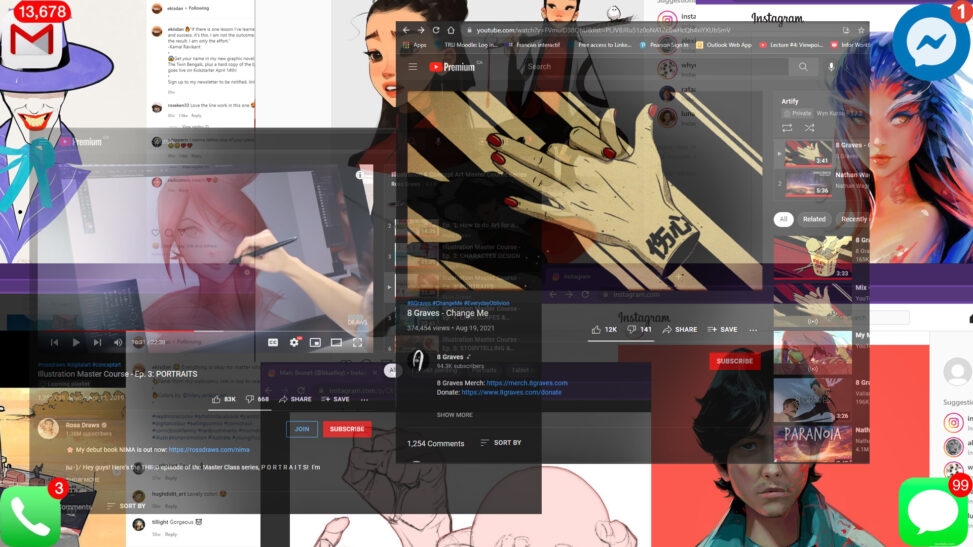Image Attribution: “Assignment 3 – SNS Analysis” by J. William Howard is licensed under CC0. (See interactive map)
J.William Howard
Terryl Atkins
VISA 1500_02
October 28, 2021
Assignment Part A – SNS Analysis
Social Networking Sites (SNS)
After monitoring my personal use of SNS’s for five days, the concept of social media addiction has become all too real. Media addiction presents itself in many forms, from checking for notifications without a prompt to needlessly scrolling Instagram for hours. However, one interesting fact was that 90% of my overall use of SNS’s was for consumption with a minor amount of communication.
Over five days, the SNS’s I used were:
- Instagram was for the consumption of images, primarily digital are from different famous members of the platform.
- YouTube was for digital art-related tutorials, tips, and tricks, focusing on current hobbies.
- Samsung Messaging is the text messaging platform primarily used to communicate with friends and family when needed.
The only app I used to create and share the content of the three was Samsung Messaging. Limiting my overall impact to simple communications and the occasional Instagram or YouTube link shared with a friend.
In many ways, my personal use of SNS’s centers around enhancing my face-to-face or “offline” persona rather than promoting or garnering online attention or fame. Text messaging being the exception, the majority of the time I spend on SNS’s is for learning activities. I admire peers’ artwork for inspiration on Instagram and learn from those same peers through their instructional videos on YouTube. Even when looking back upon past usage of these platforms, peer-related activities make up most of my viewing history, the interests may change, but the goal remains the same.
My interaction with SNS has been, for the most part, very positive. They offer an easy-to-access platform to learn new things and find people with similar interests that want to share what they have learned. Unfortunately, just as with any other aspect of life, there are downsides to using SNS’s. Most predominantly is the addictive nature of SNS and the lack of adequate representation of the consequences of consumption.
Some subtle signs of addiction I have noticed in myself as well as others include:
- Compulsory checking of smartphones for new notifications, including the sense of fantom vibrations.
- The giving and taking of attention lead to a sense of personal value both on and offline.
- Procrastination regarding daily tasks and self-care in favour of the “endless scroll” of distractions readily available.
These simple examples are some of the most common signs of SNS addiction. Voluntary and involuntary actions mirror those people who suffer from alcohol addiction experience (Kuss, Griffiths).
SNS’s are often used to allow people to experiment with social and personal ideas in a safe space. Allowing individuals to use SNS’s to aid in constructing personal identity within an online space helps improve their confidence in an offline space (Ganda 5). However, this leads to another problem, as individuals grow in an online and text-based environment, they struggle with more traditional social interaction. These virtual spaces allow for an abundance of self-correction before committing their input, leading to issues with face-to-face interactions. The instantaneous exchange of face-to-face communication lacks to ability to pause while we think up a cleaver or thoughtful response. It becomes messy and requires practice to navigate the real-time aspect of the conversation. While new emerging technologies such as Discord, Zoom, and Skype offer a more “true-to-life” conversation experience with voice communication, it is far from becoming the standard at this stage.
SNS’s provide many tools for individuals to share, express, consume, and learn from others. The provided services are an invaluable asset to those that use them safely; however, they can lead to remarkably overlooked side effects. Whether consuming, sharing, or creating SNS content, social media impacts daily life, taking up valuable time, skewing personal identity, and amplifying individual anxiety. As a tool, SNS’s provide individuals with many tools to enhance their lives both on and offline. All of these points lead to one inevitable question, “Who teaches us to be responsible with SNS?”
References
Kuss DJ, Griffiths MD. Social Networking Sites and Addiction: Ten Lessons Learned. International Journal of Environmental Research and Public Health. 2017; 14(3):311. https://doi.org/10.3390/ijerph14030311
Ganda, Madison, “Social Media and Self: Influences on the Formation of Identity and Understanding of Self through Social Networking Sites” (2014). University Honors Theses. Paper 55.
